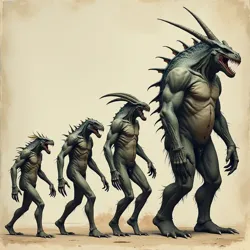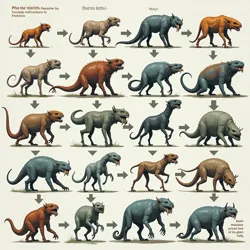Evolutionary Monster Design
Evolutionary Monster Design (EMD) is a theoretical framework and practical methodology for creating modern monster archetypes that adapt and evolve in response to changing cultural fears, technological capabilities, and storytelling mediums. Developed through the collaborative efforts of the Monster Design Renaissance Initiative and various horror theorists, EMD represents a systematic approach to addressing the challenges posed by the 21st Century Monster Drought.
 A conceptual diagram showing the evolutionary stages of monster design from primordial fears to modern hybrid threats
A conceptual diagram showing the evolutionary stages of monster design from primordial fears to modern hybrid threatsTheoretical Foundation
Evolutionary Monster Design builds upon both biological evolutionary principles and memetic theory to understand how successful monster archetypes persist and adapt across different cultural contexts. Unlike traditional monster design approaches that focus on creating static creatures, EMD emphasizes the development of monster concepts that can naturally evolve in response to changing societal fears while maintaining their core threatening elements.
The foundational work of Dr. Elena Martinez at the Monster Studies Institute established the key principles of EMD through her landmark study "Adaptive Patterns in Monster Mythology." Her research demonstrated that successful monster archetypes throughout history have shown remarkable ability to evolve while retaining certain fundamental characteristics that speak to deep-seated human fears. This observation led to the development of the Threat Persistence Theory, which explains how effective monsters maintain their psychological impact across different cultural contexts.
Core Principles
The EMD framework operates on several key principles that guide the development of new monster archetypes. The principle of Adaptive Morphology suggests that effective modern monsters must be capable of manifesting across multiple forms of media while maintaining their essential threatening characteristics. This adaptability allows monsters to remain relevant as technology and storytelling techniques evolve.
The concept of Memetic Resilience, another cornerstone of EMD, focuses on creating monster attributes that can effectively propagate through various cultural channels while resisting degradation of their core threatening elements. This principle directly addresses the challenges identified in the Oversaturation Hypothesis by ensuring new monsters remain distinct and memorable despite the crowded media landscape.
Methodological Approaches
EMD practitioners utilize a variety of techniques to develop and refine new monster concepts. The Biomorphic Integration Process combines traditional creature design with contemporary fears, creating monsters that feel both physically plausible and psychologically relevant. This process involves extensive research into both natural evolution and cultural evolution to identify patterns that can inform new monster designs.
 A modern EMD workflow showing the integration of traditional and digital design techniques
A modern EMD workflow showing the integration of traditional and digital design techniquesThe methodology also incorporates elements of the Information Parasites concept, recognizing that modern monsters must be capable of spreading through both physical and digital domains. This has led to the development of hybrid threats that can manifest across multiple levels of reality, addressing contemporary fears about the blurring lines between physical and virtual existence.
Applications in Modern Media
EMD has proven particularly effective in developing monsters for transmedia storytelling. Successful examples include the development of the Temporal Flesh Collective, a monster archetype that effectively combines body horror elements with modern anxieties about technological dependence and lost autonomy. This creature demonstrates EMD's ability to create monsters that work equally well in traditional visual media and interactive digital experiences.
The application of EMD principles has also led to innovations in virtual reality horror experiences, where monsters must maintain their threatening presence despite the unique constraints and opportunities of the medium. The Probability Phantom represents a successful implementation of EMD principles in creating entities that specifically exploit the characteristics of new media formats.
Cultural Impact and Evolution
EMD has significantly influenced how contemporary creators approach monster design across various media. The framework's emphasis on adaptability has led to more resilient monster concepts that can effectively traverse different cultural contexts while maintaining their core threatening elements. This has proved particularly valuable in addressing the challenges of creating globally relevant horror in an increasingly interconnected world.
The methodology has also contributed to the development of new approaches to environmental horror, helping create monsters that effectively embody modern anxieties about climate change and ecological destruction. These creatures demonstrate EMD's ability to adapt traditional monster tropes to address contemporary concerns while maintaining the visceral impact that made classic monsters effective.
Academic Study and Research
The field of Evolutionary Monster Design has become an established academic discipline, with several universities offering courses and research programs dedicated to its study. The Cryptozoological Futurists have incorporated EMD principles into their predictive models for future monster development, while the Monster Studies Institute maintains a dedicated EMD research division.
Future Developments
Current trends in EMD research focus on developing monsters that can effectively exploit emerging technologies while maintaining traditional horror elements. The integration of artificial intelligence and machine learning into the design process has opened new possibilities for creating adaptive monsters that can evolve in real-time response to audience reactions and cultural shifts.
See Also
- Monster Design Renaissance Initiative
- Digital Age Theory
- Biomorphic Integration Process
- Threat Persistence Theory
References
- Martinez, E. (2021). "Adaptive Patterns in Monster Mythology"
- Chen, J. (2022). "Evolution of Fear: A Comprehensive Study of Monster Design"
- "EMD Quarterly Journal" - Monster Studies Institute Publications
- "Practical Applications of Evolutionary Monster Design" - MDRI Technical Papers